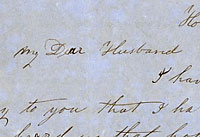
Lesson 3
Transcribing a Primary Source
- Time Required: 90 minutes
- Curriculum Fits: History and English/Language Arts
Lesson Overview
In this lesson, students consider the challenges facing researchers of primary sources and try their hand at transcribing a letter from 1865. They will analyze the language style of the letter and rewrite it into modern language.
Learning Objectives
- Students will identify the challenges presented when transcribing primary source documents.
- Students will understand what transcription is and experiment with the transcription process.
- Students will analyze the language style of a personal letter from the 1850’s.
- Students will identify and analyze how an author’s words appeal to the senses, create imagery, suggest mood and set tone.
- Students will gain an understanding of how an individual in 1850 might communicate with a loved one far away.
Materials
- copies of 1855 Letter from Susan to Peter Cromwell (artifact collection)
- copies of a transcription of the beginning part of the 1855 Cromwell Letter (see “Read Text” option in artifact collection)
- student worksheet: Transcription Form
- student worksheet: Language Style Analysis Form
Procedure
- Explain to the students that one of the challenges in using primary source documents is deciphering the text and that transcription is the process of converting something written from one format to another, in this case, from old handwriting to modern handwriting or typewritten text. Let them know they will be working with a letter from a whaling wife living on Martha’s Vineyard in 1855 to her husband, a whaling captain at sea in the Pacific. They will try their hand at transcribing the letter and will analyze its style.
- Hand out copies of the 1855 Letter. Give students time to look it over, guiding them in a discussion of their observations. What do they think of the letter? What do they notice when they look at the handwriting? Can they read it? Parts of it? How long might it take them to read the whole thing? What makes it difficult to read?
- Hand out copies of the transcription of just the beginning of the letter. Ask students to compare the two versions. Discuss similarities and differences and generate a working definition of transcription. Which is easier to read? Why?
- Demonstrate transcribing a sentence or two for the students and then hand out the Transcription Form. Give students time to try transcribing the next sentence in the letter. Ask students to write their transcriptions on the board. Are they all the same? If not, why? What caused the transcription differences/errors? What are the challenges presented by the transcription process?
- Work through the next few sentences in the letter as a class, helping the students to “think aloud” as they work.
- Have students work in their small research groups to continue transcribing the letter.
- Once they have transcribed a good portion of the letter, give students copies of the Language Analysis Form. Have them discuss the letter within their groups, filling out the form. Give them time to share their analysis and guide them in a discussion of how the style and content of the letter help to set a tone for the communication.
- Bring the class together to share their analysis of the style of Susan Cromwell’s letter to her husband. What might this tell us about communication in the 1850’s? About the relationship between Susan and Peter? About life for whaling wives and whalemen during that period? Discuss the role of language style in written communication. How might analyzing language style help them in their research?
Assessment
Ask students to imagine themselves as a family member of a sailor on a whale ship in the 1850’s. Have them write a short letter to him in a style that would be appropriate to the time period.
Homework Assignment
Using the information on the language analysis form completed in class, write a one-page response to the question: What does the style of Susan Cromwell’s letter tell us about letter writing in the 1850’s? Be sure to mention specific examples from the letter to support your ideas.